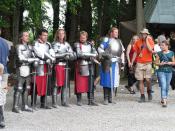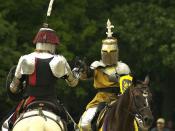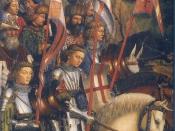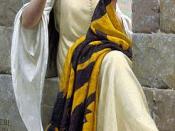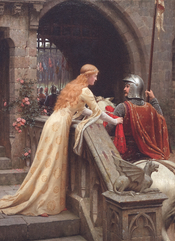Chivalry: A lost code Chivalry. A term not widely used during the modern times. What exactly is chivalry? According to Webster's New World Dictionary, it is "the medieval system of knighthood,"ÃÂ and also "courtesy and fairness."ÃÂ Chivalry is almost nonexistent in today's society. It lives on in the form of good manners and "courtly love." Chivalry originated in the 9th and 10th centuries, at which time Western Europe was under siege by invading groups of Vikings, Magyars, Muslims, and other tribes. These invaders were usually experts at waging war on horseback. The armies of the European nobles had no such advantage; they were mainly composed of mere foot soldiers that had great difficulty combating the mounted cavalry. As a result of this, the nobles began to employ cavalry training and tactics in order to counter the threats of invaders. The first knights were simple armed warriors who fought on horseback with lances and swords.
Horse maintenance was expensive, and cavalry training was a long and difficult process. To make up for the expenses of cavalry training, the nobles started to grant land to their knights for the duration of their services. This land provided the necessary income to support the knight.
Cline 2 Chivalry can be divided into three main viewpoints: the military, the social, and the religious.
The Military Standard Knights were expected to defend their lords as well as the innocent. The knight was known as the professional soldier of the time. Usually only men of noble birth had the honor of being knighted. Each year a knight was expected to perform a specific number of days of military service in exchange for his lands and the lord's protection. A knight was also expected to fight valiantly for his lord, and show unquestioning loyalty to him. Bravery and loyalty were the foundation of what was to become the code of chivalry. A would-be knight began his training at an early age, serving as a page in a knight's household. In his teenage years, he graduated to the status of squire, where he gained more responsibilities. He now tended his knight's horses, of which every knight had three, the battle horse, a second horse, and a packhorse for the luggage. The squire also tended to his knight's armor. The squire also gained his first battle experience. Usually several squires were apprenticed to a knight at the same time. Generally there were four: one to manage the horses, one to carry the heaviest weapons, such as a shield, one to aid his master in mounting his horse and raise him if he was dismounted, and finally a fourth to guard any prisoners the knight might take, especially if a high ransom was placed upon them. Having attendants was a good thing for the knight, for when on the battlefield they might Cline 3 band together as a small infantry unit to fight around their master. It was at this time that they learned the many skills in arms that were essential for their profession. When the squire was to be knighted, he was welcomed into the order of knights by either being named with a sword or slapped in the face by his lord. The new knight would then receive a fief, or grant of land as a reward for his training and would from then on be called "Sir"ÃÂ before his name.
The Social Standing Being a knight was a mark of social distinction. Knighthood was limited to those of noble birth. Only a knight's sons were allowed to join its ranks. As mentioned earlier, the knight's sons were sent off at an early age to some noble's court where they learned the arts of combat as well as the arts of courtesy. When they were twenty-one years of age, they were knighted. When the circumstance of birth was lacking in the candidate, the ruler alone could create a knight, as part of his royal privilege. Knights were expected to follow the code of chivalry and courtly love very fervently. The actual written code of chivalry is too lengthy to list, but it falls under ten main commandments, as follows: I. Thou shalt believe in all that the Church teaches, and shalt observe all its directions II. Thou shalt defend the church III. Thou shalt respect all weaknesses, and shall constitute thyself the defender of them IV. Thou shalt love the country in which thou was born V. Thou shalt not recoil before thine enemy VI. Thou shalt make war against the Infidel without cessation, and without mercy VII. Thou shalt perform scrupulously thy feudal duties, if they be not contrary to the laws of God VIII. Thou shalt never lie, and shall remain faithful to thy pledged word IX. Thou shalt be generous, and give largess to everyone.
X. Thou shalt be everywhere and always the champion of the Right and the Good against Injustice and Evil Cline 4 The Holy Warrior Knights were raised in the laws of the church and all that was holy. This is why they were held in such high regard by the "commonfolk."ÃÂ In the early teachings of chivalry, Tertullian taught that Christianity and the use of weapons were ill-assorted. This teaching was condemned as heretical and the military career of a knight was regarded with little support. In chivalry, religion and the vocation of weaponry were acquiescent. The clergy thought it best to demand a religious vow from the rough warriors of the medieval times to use their weapons chiefly for the protection of women and children, as well as any other defenseless person. Chivalry was a vow that dignified the soldier and raised him to a high level in society almost in equal standing with a monk. The church, in return for this vow, designed a special blessing for the knight in the Pontificae Romanum. This ritual started off a simple one, but later evolved into a more complex and elaborate one. Before the sword was blessed on the altar, several things were required beforehand of the knight to be, such as confession, a vigil of prayer, fasting, a symbolical bath, and the donning of a white robe, to represent the purity of soul that the knight would have upon entering his career. When this was done, he knelt before the clergy, pronouncing his solemn vow of chivalry to them, then they struck him lightly on the neck with the blessed sword in the name of God and St. George.
Cline 5 Chivalry flourished in the 9th and 10th centuries, declining in the 16th, around the time that gunpowder was invented. Chivalry is a forgotten code in that hardly any of it's ideals are with us today. It lives on in two forms: manners, and courtly love. To be a knight was considered a great honor and living by chivalry was a knight's duty. To sum up chivalry in one quote, " Zealous, yet modest; innocent, though free; Patient of toil, serene amidst alarms; Inflexible in faith, invincible in arms."ÃÂ -The Minstrel, Book i, stanza 11. --James Beattie. Cline 6 Works Cited "Chivalry,"ÃÂ Encarta Interactive Encyclopedia, CD-Rom. Encarta Inc. 2000 "Chivalry."ÃÂ New Advent Encyclopedia. "Knights and Knighthood."ÃÂ WorldBook Encyclopedia copyright 1999, WorldBook Inc: 348-350 "Knights and Chivalry."ÃÂ My Chivalry Page.
Soergel, Phillip M. Chivalry.
, 1998
